I’m in a maundering mood, trying to pin down the meaning of a tiny revelation I had the other day.
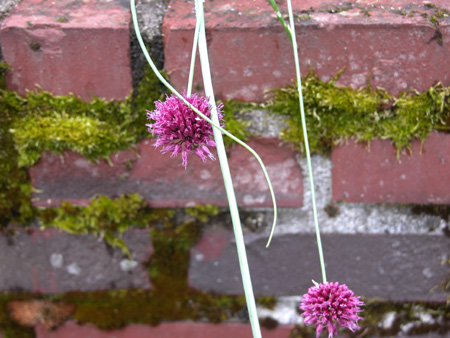
I was doing my 7 AM walk with my digital camera, getting photos of flowers, shrubbery, moss, walls, the usual panoply of residential flora on the pleasant July streets of Portland Oregon. But suddenly I found myself seeing the foliage and supports, stems and stamens, bricks and buds, as Art.
Aesthetic Art.
Now I’m a longtime nature lover and have always thought of nature as good for art (and perhaps vis-versa). But I had never had my vision overwhelmingly charged with the groupings of nature as embodying the basic elements of design — field and composition, shape, line, and form, texture and color — done not by me or even by my eye, but simply there, ready for the seeing. Of course, I have taken pictures which are artfully composed. But somehow my vision of nature qua photography was that my compositions were not nature’s but rather mine, achieved by leaving things out, zooming in, choosing the point of view.![]()
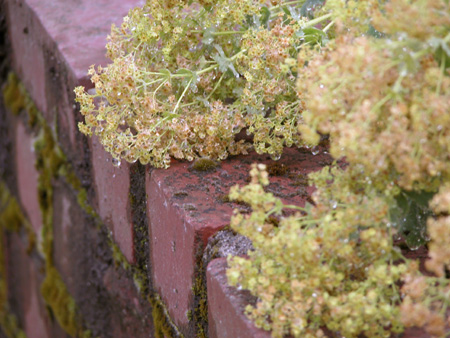
But this revelation was that the groupings themselves were natural and artful.
The rest of my walk was charged with this sense of coming upon the artful arrangements of nature — shape, form, line, texture, color, unity, harmony, balance — all those basics simply evident, all around me.
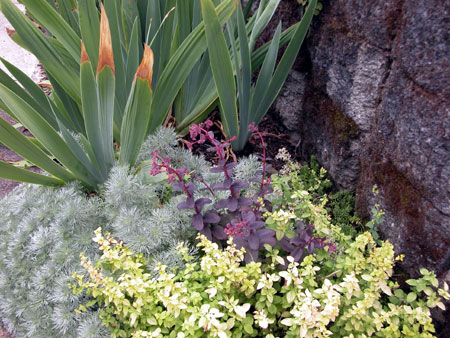
I was trying to explain this revelation to Jer, but he just looked puzzled. Of course, he said, garden flowers are beautiful, of course we compose our photos and crop them for the best design features.
And then he switched the conversation to what seemed to be a different topic altogether, focusing on the astronomy picture of the day for 2007 July 17. It’s an example of an optical illusion, of which there are many more on Michael Bach’s optical illusion site.
Bach says,
Optical illusion sounds pejorative, as if exposing a malfunction of the visual system. Rather, I view these phenomena as bringing out particular good adaptations of our visual system to standard viewing situations. These adaptations are »hard-wired« in our brains, and thus under some artificial manipulations can cause inappropriate interpretations of the visual scene. As Purkinje put it: »Illusions of the senses tell us the truth about perception« (cited by Teuber, 1960).
I had to ponder on the connection Jer had made, but I think now I get it. Perhaps I received the opposite of an optical illusion, perhaps an illusion in my perception was removed, perhaps my brain had suddenly connected the wires (or crossed them) and I got that electrifying instance of art and nature being one.
This then got connected to a somewhat different attribute of nature that I’m very aware of — that it’s always in flux and seldom absolutely in control. So the design elements that I observed in the floral “arrangements” that morning would probably be changed by the afternoon — a worm would have eaten into a leaf, a stem would have broken, the petals would begin to drop. Which then brought me to the conundrum of my life.
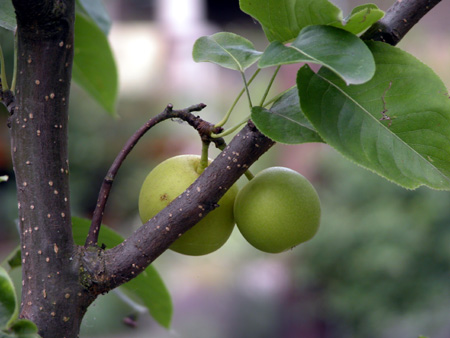
I have always maintained that death is the mother of beauty (a line from a Wallace Stevens poem which has that as its theme). The temporal nature of existence is what makes it and all that surrounds it (i.e. nature) beautiful. And yet at the same time I had also thought of Art as eternal, or as eternal as the human entity can manage. I think there’s a connnection between eternal flux and natural art, perhaps that you can’t step into the same river twice, and yet it’s the same river.
I’m not sure where I’m going with this — maybe I’m just playing with words. And my vision of the foliage decorating my morning walks has returned to its ordinary pleasantness, without the charged electricity of the mingling of nature and art.
But I haven’t quite gotten over the experience.
Lawrence Weschler, in To See is to Forget the Name of the Thing One Sees quotes Robert Irwin talking about the complexity of consciousness:
“It’s like you’re on a swing, and you swing way up to the top and for a split second you can see over the wall, you can see all that light, but you’re already on your way back into the world. So you swing harder and you get a little higher and you see a little more, but back down into the world you go. To recognize something and then live there takes a tremendous conversion of your being. You don’t just swing up there and say, ‘Oh,that’s nice,’ and stay there, hanging in midair. Hanging in midair can be nice…. But the world always draws you back.”
Has anyone else had this kind of revelatory moment, when art and something else merged for a moment and then disengaged?
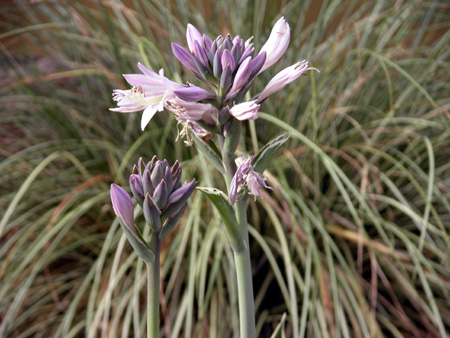
The photos in this post were all taken on that morning of my fleeting integration of art and nature, external and internal, mind and vision and reality.

June,
Beautiful. All of them.
I had similar experience years ago in the Bay Area:
I am on the subway sitting behind a man wearing a suit of another generation that probably fit his trimmer youth. He is a black man with a wide collar and a sturdy build. These observations are brief as my attention is soon devoted entirely to his right ear. It is full and compact. It fits him perfectly.
This happened nearly twenty years ago; it really was a transition life experience that opened a much larger and more specific world to me.
Great post, June, this has so much that will be fun to grapple with. I think I and other photographers have experienced a similar feeling to yours as a time when there are great photographs everywhere you turn, as opposed to most days, where most things don’t especially appeal and you have to work to get anything passable. That’s a surface level response, I think your musing geets to much deeper stuff about art, nature, and perception. More later on that.
I have to say that, spontaneous though they may have felt, the images you present are all highly composed, by which I mean very particular views, not what you would see in most images if you “randomly” framed them. To perhaps oversimplify: the first is straight on aligned to the bricks to highlight the orthogonality-breaking foreground subject; second and third put the brick wall so that the strong diagonal out of a corner anchors the composition (I do this a lot myself); the apple trunk and branch again use strong vertical and major diagonal, this time with nominal subject behind; and the last gives us a spray from the center. So I think it was your eye (by which I mean your perceiving brain, of course) that was “in the zone” that morning.
The optical illusion you point to is one of my favorites, and a crucial one that visual artists use to extend the apparent brightness range in a picture, when really there is a very limited range physically possible with normal paints or photographic paper. But I would connect it to your seeing epiphany as follows: something that appears simple and natural (the shaded chessboard or the artistic vignettes you saw) actually relies on sophisticated processing by the brain that you’re not aware of, you’re just the lucky beneficiary of it.
Steve,
“lucky”?
Fortunate?
Hi all,
thanks for the comments. The ear I paricularly like and as I will be getting on the ferry in a few minutes, I will see if I can see one.
I probably won’t be able to access A and P for four or five days, but I’ll respond as soon as I can get on-line.
June:
I’m having a “duh” moment as the astronomy shot I’m getting is Armstrong’s shadow. It is surrounded by a halo effect, which is often visible from a plane if one can see one’s shadow on the ground.
Should we all have such blessed times as yours. Your post concerning that day is prompting some interesting responses. For me it would be a few questions: were you seeing things otherwise blanked by larger effects?
Your blog is a virtual diary of the arboreal seasons in Portland and a few months back was replete with a grand splash of blooming things- a fanfare of color. The images that you are showing us here speak more quietly and with a more particular articulation. This is a nature of structure – sharp edges, contained forms and lines. The somewhat muted colors and textures are more in keeping with the human presence. The very plants seen in your images might appear in the lava fields to the east, whose flows can be brick like. I can imagine homes in your neighborhood painted in some of these hues.
Would you think that this merging of the natural and the man made may have quickened your response?
Another question: did that feeling of things assembling themselves occur at other scales and distances? Was Mt. Hood, peering over the tree tops, part of the effect? The skyline over there?
Finally, do the images rekindle that feeling in you now? I always admire your photography and am trying to find in these pictures a distillation, perhaps, that varies from or improves upon your accustomed vision. I keep coming back to the keen sense of structure here and wonder if the spirit of Cezanne was with you.
Both the river and the “you” who is stepping.
Merged and disengaged more often than I can remember. The merging effect is usually accompanied by a hollow sound as I hit myself upside the head for not bringing a camera.
Jay,
There’s now a link from the 2007 July 17 date to the specific picture June referred to.
Interesting point about the “merging of the natural and the man made.” Presumably the human eye recognizes and tends to be stimulated by human arrangements, artful or otherwise.
I take the Staten Island ferry to work every morning and oftentimes I decide not to read the Times but stand at the bow of that great boat.
The spilling breakers of the New York harbor are rudely cut by the course of the ferry every time.
Steve:
Thanks for clearing that up. I still don’t get it. Looks like I’ll have to wait awhile for a clarification.
June:
Speaking of the “charged electricity of the mingling of nature and art”, I’m trying to remember the name of the fellow who put up an entire field of big lightning rods in maybe New Mexico. Electricity would impinge upon the earth in the specific manner dictated by the array. It ended up that other charges were pending as a thief or thieves ran away with the array. Shocking!
Steve,
To me, “Lucky” and “Fortunate” both suggest being more passive than certainly my experience.
Jay,
Walter de Maria’s “Lightning Fields”.
Jay, I don’t get a specific connection either, only that both highlight “mysteries” in how we perceive the world.
D., I think passive is accurate in the sense that June’s experience, like the optical illusion, did not result from consciously trying to see in a certain way (as I understood it). I think one can more actively learn to see that way, and in any case the tendencies of the vision/mind system do result, in part, from what and how we choose to observe.
D:
Walter de Maria it is. New poles must have been installed as the Dia Foundation maintains a viewing post nearby.
I think it’s a shame
when I mistake a bird for a plane.
A weakness on my part,
an inability to accept
once again
that everything is in flux
and I see only what I know.
Because I worry too much about
constant motion
and change
until I can no longer
see what is in front of my eyes.
Because I fill my brain with the concerns of an
internal combustion engine, and music
and television
in order to convince myself all is okay.
It’s okay.
But it all
leads me to this moment of
temporary blindness to that which
pumps blood and builds nests.
Then once again I come
to the two primary beliefs
that all is motion
and all is connected without attachment,
and everything has its place
in the universe,
including me,
and my occasional
cock-eyed vision.
I wrote this over two years ago. It seemed to fit and I hope it’s ok to post it.
Seems to fit, indeed. These experiences appear to be common in that most people have had them, but not as common for each of us as we might like.
June,
A rich post that stimulates thinking of brain wiring, Cezanne, epiphany, and motion.
Steve,
I am curious about your
Intriguing question, June. I often wonder also, why should nature be so beautiful? We must be designed to appreciate it.
Sorry I didn’t notice your prod before, Birgit. Karl has touched on part of what I was thinking, namely the general idea that we can feel in tune with nature because we actually are part of nature and adapted to respond viscerally to it. Still, that’s not enough because it doesn’t explain why it isn’t always like that; why there are times when, on the contrary, nothing seems attractive or well-composed. But if I had something more profound to say, I’m afraid I’ve forgotten it by now. Maybe tomorrow will be one of those days and it will all come back.
Steve,
I’ve been thinking about your Junkyard Treasures and wondering if Nature really has a special place, or if it is something we learn to like.
June,
I think that the nature that you view as art in itself is essentially that. But in presenting it to others, it becomes necessary to transform and represent it in a conventional form.
All,
I’m two weeks distant from my post and a bit lost in the plethora of comments (not to mention having had a vacation and an extended bed stay between the posting and the present).
But to try to respond, however feebly —
Jay, Portland’s foliage and streets are all encompassing, all surrounding, particularly in the summer. Mt Hood never appears unless you search for some artificially exposed piece of sky from Mount Tabor or the West Hills; so to answer one of your questions — my attention was almost wholly on the small rather than the large and there were no grand vistas that loomed.
Karl, I think I was trying to get at something like you expressed — along the lines of what Tree wrote in her poem. The reversed optical illusion that this kind of experience gives one made me wonder if I wasn’t for the first time seeing truly rather than seeing through a category (Tree’s plane/bird).
I do understand that I’ve been training myself to see in this way and that perhaps it merely was a moment when my training came into full focus (as Steve, I think, suggests). But there are other possibilities, one being that nature itself is this and sometimes we can actually see it. Another is that it isn’t a “seen” event so much as it is a “felt” event, transformed, as Karl puts it, into a conventional photographic form for verbal discussion. That is, perhaps I could make similar photographs without the “feeling” but it’s the feeling that infused the morning with meaning. To discuss it, however, I had to present the photographs as evidence of the ineffable.
Anyway, I’ve lost most of the train of thought the post came from. And I see that Jay had a question that I’m not comprehending. If you keep poking at me, Jay I might do better at responding. But the conversations have gone on in interesting and fruitful directions the meantime and so I’m happy to lay this to rest.
Guys:
How do you get those quote blocks from other comments into yours?
June:
Good to see you back. Perhaps you can concoct an issue from your adventures upon which we can glom.
Mt. Hood seemed visible enough when I was there. But then I have an uncanny x-ray vision when it comes to such things.
Jay,
You had either x-ray vision or you lodged in one of those spendy high-rises that dot the Portland landscape. Oops, I forgot — I believe it was Chez Underwood that hosted you. Anyway, if it ain’t the clouds, it’s the foliage that keeps us from MS Hood’s moody visage.
As for issues from adventures, I’m thinking about the painting of fog. And trying. And thinking. And trying. But this isn’t a painting class.
June:
And yet I cut through it all.
You are, of course, referring the the well-decorated b&b with the world’s longest kitchen floorboard.
I do remember a someone who would venture to an island off Scotland thereupon to paint the outlandish weather in all its various billowings. As I recall, he had adopted the Turner palette, in spirit if not in actual fact.
The question of painting (or photographing) fog sound interesting to me. Echoes one a while back on representing transparency.
On indented comments, called blockquotes: just enclose the text within start and stop blockquote tags. Tags must use angle brackets < and >, but to make them visible to you I’m showing square ones:
[blockquote]my text[/blockquote]
Replace the squares with angles and you get